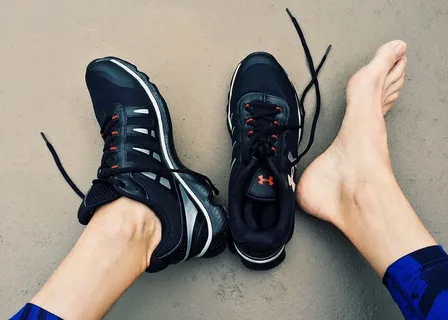Post-surgery plantar fasciitis can be an extremely painful and frustrating experience. The best way to manage the pain and speed up recovery is to wear the right Walking Shoes For Plantar Fasciitis. Finding the perfect shoes for post-surgery plantar fasciitis relief can be a challenge, but with the right information and knowledge, it can be easier than you think. In this blog post, we’ll discuss the essential features to look for when shopping for the best shoes to wear after plantar fasciitis surgery.
Cushioned Heel
One of the most important features to look for in shoes designed for plantar fasciitis relief is a cushioned heel. The heel of your foot is under constant pressure with each step you take, so it’s important that your shoes provide adequate support to reduce the stress placed on the plantar fascia. A cushioned heel not only provides additional shock absorption, but it also helps to distribute weight evenly across the foot, which can alleviate pain and discomfort.
When shopping for shoes for plantar fasciitis relief, look for shoes that have a well-cushioned heel. You may want to consider shoes with a removable insole, as this allows you to replace the insole with a custom orthotic or insole for added comfort and support. Shoes with a thick and soft heel pad, such as memory foam, are also a great option as they provide extra cushioning and help absorb impact as you walk.
In addition to cushioned heels, it’s important to look for shoes with a supportive arch and good overall fit to ensure your feet are well-supported and protected. Keep in mind that every person’s foot is unique, so it’s essential to try on different styles and brands to find the right fit for you.
Overall, finding a pair of shoes with a cushioned heel can go a long way in reducing pain and discomfort caused by plantar fasciitis, making it a crucial feature to look for in any footwear designed for plantar fasciitis relief.
Metatarsal Pad
Another important feature to look for in shoes for plantar fasciitis relief is a metatarsal pad. The metatarsal pad sits just behind the ball of the foot and helps to redistribute pressure away from the inflamed plantar fascia. This can be especially beneficial for those suffering from metatarsalgia, which is pain in the ball of the foot.
The metatarsal pad can also help to improve overall foot function and prevent excess pronation or supination. It can provide a supportive base for the foot, which can help to reduce stress and strain on the plantar fascia.
When looking for shoes with a metatarsal pad, it’s important to make sure that it is properly placed and sized for your foot. A metatarsal pad that is too large or too small may not provide the intended benefits.
Overall, a metatarsal pad can be a great addition to shoes for plantar fasciitis relief. It can help to improve foot function and reduce pain and discomfort in the ball of the foot. Be sure to look for shoes with this feature if you suffer from plantar fasciitis or metatarsalgia.
Shock Absorption
One of the most important features to look for in shoes for plantar fasciitis is shock absorption. When you walk, your feet are subjected to repeated impact, which can aggravate the condition and cause pain. Shock absorption helps to absorb the impact and reduce the pressure on your feet. This is especially important if you have plantar fasciitis, as the condition can be exacerbated by excessive impact.
Look for the Best Shoes For Achilles Tendonitis And Plantar Fasciitis that have good shock absorption in the heel and forefoot areas. This will help to reduce the pressure on your feet and prevent pain. Many shoes have special cushioning materials or air pockets that help to absorb shock. Gel inserts can also be helpful in providing extra cushioning and reducing shock.
When trying on shoes, make sure to walk around and test the shock absorption. You should feel a noticeable difference in the impact on your feet compared to shoes that don’t have good shock absorption. You may also want to consider shoes with a slightly wider sole to help distribute the impact and reduce pressure on your feet.
Remember, shock absorption is just one feature to look for in shoes for plantar fasciitis. It’s important to find shoes that are comfortable and provide good support for your feet. By finding the right shoes, you can help to alleviate pain and discomfort associated with plantar fasciitis and get back to enjoying your daily activities.
Motion Control
Another essential feature to look for in shoes for post-surgery plantar fasciitis relief is motion control. This means that the shoes are designed to prevent excessive inward rolling of the foot, also known as overpronation. Overpronation can exacerbate plantar fasciitis and Achilles tendonitis by putting extra pressure on these areas.
Shoes with motion control typically have a stiffer midsole and a firm heel counter to provide added stability and support. This helps to keep the foot in a neutral position and prevent it from rolling inward. Look for shoes with a straight last design, which means that they have a straight line from heel to toe, rather than curving inward at the arch.
While motion control shoes may not be necessary for everyone, they can be a great option for those with moderate to severe overpronation. They can also be helpful for individuals who are overweight, as excess weight can contribute to overpronation and foot pain.
Overall, finding the best shoes for post-surgery plantar fasciitis relief involves considering a range of features, including cushioning, metatarsal support, shock absorption, and motion control. By choosing shoes with these features, you can help to reduce pain and promote healing as you recover from plantar fasciitis surgery. It’s important to note that motion control shoes may not be the most stylish or flexible option, but they can be highly effective for providing the necessary support and stability. If you prefer a more flexible shoe, look for those that offer moderate motion control, which provides some stability without sacrificing flexibility.
When choosing motion control shoes, it’s also important to ensure that they fit properly.
Shoes that are too tight or too loose can cause further discomfort and exacerbate plantar fasciitis symptoms. Consider getting measured by a professional or using an online shoe size calculator to determine the correct size.
Overall, finding the right shoes for post-surgery plantar fasciitis relief may take some trial and error. However, by considering these essential features and finding shoes that fit properly and provide adequate support, you can help to alleviate pain and promote healing after surgery. Remember to always consult with your doctor or healthcare provider for personalized recommendations and guidance. Additionally, it’s important to break in new shoes gradually to avoid further discomfort or injury. Start by wearing them for short periods of time and gradually increase the duration as your feet become accustomed to the shoes. It’s also helpful to rotate your shoes and avoid wearing the same pair every day, as this can lead to excessive wear and tear and reduce the shoes’ effectiveness.
Additionally, it’s important to break in new shoes gradually to avoid further discomfort or injury. Start by wearing them for short periods of time and gradually increase the duration as your feet become accustomed to the shoes. It’s also helpful to rotate your shoes and avoid wearing the same pair every day, as this can lead to excessive wear and tear and reduce the shoes’ effectiveness.
Lastly, don’t forget about proper foot care outside of wearing supportive shoes. Stretching exercises, icing, and massaging your feet can all help to reduce pain and promote healing. It’s also important to avoid activities that exacerbate foot pain, such as high-impact exercises or standing for extended periods of time. In summary, the best shoes for post-surgery plantar fasciitis relief should provide cushioning, metatarsal support, shock absorption, and motion control.
Motion control shoes can be highly effective for individuals with moderate to severe overpronation.
It’s important to ensure that the Best Shoes To Wear After Plantar Fasciitis Surgery fit properly and are broken in gradually. By combining proper shoe selection with stretching and foot care, you can help to alleviate pain and promote healing after plantar fasciitis surgery. When shopping for motion control shoes, be sure to try them on and walk around in them to get a feel for how they fit and how they support your feet. Look for shoes with a deep heel cup, which helps to stabilize the foot and reduce inward rolling. The midsole should also be firm and provide plenty of support for the arch.
In addition to motion control, it’s also important to consider shock absorption when choosing shoes for post-surgery plantar fasciitis relief. Shock absorption helps to reduce the impact of each step, which can help to alleviate pain and prevent further injury. Look for shoes with a cushioned sole or midsole, which can help to absorb shock and provide added comfort. However, be cautious of shoes that are too soft or squishy, as they may not provide adequate support and can exacerbate foot pain.
Metatarsal support is another important feature to consider when choosing shoes for plantar fasciitis relief. The metatarsals are the bones in the front of the foot, and excessive pressure on this area can exacerbate foot pain. Look for shoes with a metatarsal pad, which helps to distribute pressure evenly across the foot and reduce pain in this area. The pad should be placed behind the ball of the foot, just behind the toes.
Overall, finding the right shoes for post-surgery plantar fasciitis relief involves considering a range of features and factors. By prioritizing motion control, shock absorption, and metatarsal support, you can help to alleviate pain and promote healing as you recover from surgery. It’s important to take the time to find shoes that fit properly and provide adequate support, as this can make a significant difference in your comfort and recovery. With the right shoes and proper foot care, you can get back on your feet and resume your daily activities without pain or discomfort.
Conclusion
Finding the right pair of shoes after plantar fasciitis surgery can be a daunting task, but it’s crucial for a successful recovery. A good pair of shoes can provide the necessary support and cushioning to help alleviate pain and prevent further injury. When looking for post-surgery plantar fasciitis shoes, it’s important to keep in mind the essential features, such as a cushioned heel, metatarsal pad, shock absorption, and motion control. With these features, you can be on your way to a pain-free recovery and get back to your regular activities in no time. Don’t let plantar fasciitis hold you back from living your best life, invest in a pair of quality shoes today.

